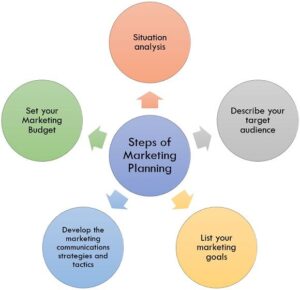Marketing Planning Process SS1 Marketing Lesson Note
Download Lesson NoteTopic: Marketing Planning Process

A marketing plan outlines the specific actions you intend to carry out to impress potential customers and clients of your products and/or services and persuade them to buy the products and/or services you offer. A marketing plan may be developed as a stand-alone document or as part of a business plan. Either way, the marketing plan is a blueprint for communicating the value of your products and/or services to your customers.
An effective marketing plan defines how and why the company is in business, what markets are good targets for its products, and how customers should be persuaded. With a marketing plan in place, a company uses the plan to measure how effectively corporate goals have been met.
It is important to carry out research before completing your marketing plan. By doing so, it will help you to be organized, so that you will be able to achieve your goals. A thorough marketing plan will provide details on what you want to accomplish with your marketing strategy and it will assist you in achieving your goals.
A marketing plan will achieve the following objectives:
- It will enable companies to look internally to fully understand the impact and the results of past marketing decisions.
- It equips companies to look externally to fully understand their target markets and the competition available in those markets.
- Set future goals and provide direction for marketing initiatives. The goals should be understood and supported by everyone within the company.
- It focuses on issues related to the four Ps: product, price, promotion and place.
Addressing these issues and putting them into written form can be useful for business owners, in that it forces them to analyze their business. It can be good for employees, as the marketing plan can provide them with essential orientation and be a source of motivation.
Creating a solid marketing plan can be the difference between a successful marketing campaign and a failed one. As most people have already experienced, marketing can be an expensive and complicated endeavour. A marketing plan will help you determine your marketing strategy by specifying your objectives, defining your goals, and targeting your market in an effective, timely and cost-efficient manner.
In today’s economy, it is crucial to get most of your money back after investment. A marketing plan will define what works for you and what does not, who you should target and who you should not, where you should allocate funds and resources, and where you should not, etc. But before you develop your marketing plan, you should state your Marketing Plan Objective.
Your Marketing Plan Objective is simply a statement defining the purpose of your marketing campaign.
Quick Tip: Your Marketing Plan Objective should be realistic, measurable and time-specific.
KEY ELEMENTS IN MARKETING PLANNING
- Situation Analysis: This introductory section contains an overview of your situation as it exists today and provides a useful benchmark to refine your plan in the coming months. Begin with a short description of your current product or service offering, the marketing advantages and challenges you face, and a look at the threats posed by your competitors.
Describe any outside forces that will affect your ness in the coming year. This can then be anything from diminished traffic levels to a retailer, due to construction. If you have a change in law that could affect a new product introduction if you are an inventor, for example.
- Target Audience: All that is needed here is a simple, bulleted description of your target audience. If you are marketing to consumers, write a target-audience profile based on demographics, including age, gender and any other important characteristics. Marketers should list their target audience by category (such as lawyers, doctors, and shopping malls) and include any qualifying criteria for each.
- Goals: In one page or less, list your company’s marketing goals. The key is to make your goals realistic and measurable so that you can easily evaluate your performance. “Increase sales of peripherals” is an example of an ineffective goal.
You should be in a better position to gauge your marketing sales of peripherals 10 per cent in the first quarter, 15 per cent in the second quarter, 15 per cent in the third quarter and 10 per cent in the fourth quarter.”
- Strategies And Tactics: This section will make up the bulk of your plan, and you should take as much space as you need to give an overview of your marketing strategies and list each of the corresponding tactics you will employ to execute them.
Here is an example: A marketing client of mine markets videotape and equipment. One of her goals is to increase sales to large ministries in three states by 20 per cent. Together we have developed a strategy that includes making a special offer each month to this prospect group, and one size or one of her tactics is to use monthly emails to market to an in-house list.
Your tactics section should include all the actionable steps you plan to take for advertising, public relations, direct mail, trade shows and special promotions. You can use a paper calendar to schedule your tactics or use a contact manager or spreadsheet program. What matters most is that you stick to 5. b your schedule and follow through. A plan art on paper is only useful if it is put into action.
- Budget Breakdown: The final section of your plan includes a brief breakdown of the costs associated with each of your tactics. So, if you plan to exhibit at three trade shows per year, for example, you will include the costs to participate in the shows and prepare your booth and marketing materials. If you find out that the tactics you have selected are too costly, you can go back and make revisions before you arrive at a final budget.
STAGES IN MARKETING PLANNING
- Develop Marketing Objectives: Under this stage, marketing objectives are stated as specific, measurable, attainable, all realistic and with a clear time frame. It is then communicated down the line.
- Develop The Marketing Strategies: Marketing strategies are broad actions to be taken to achieve marketing objectives.
- Develop The Marketing Tactics: Marketing tactics are specific actions to be taken by specific persons at stipulated times.
- Determine Budget: The budget is the financial implication of implementing the marketing strategies.
- Implementation: This involves the ac virtual execution of the marketing object additives and strategies.
- Evaluation And Control: This is concerned with comparing performance with standard performance and determining deviations for control purposes.
IMPORTANCE OF MARKETING PLANS
- It provides direction for all your marketing efforts.
- It helps define specific tasks.
- It helps to identify prerequisites to planned activities.
- If more than one person is involved, it helps you to define areas of responsibility.
- It can give you insight into new markets that may have previously been overlooked.
- It enables you to create clear guidelines for evaluating the effectiveness of different marketing methods.
- It can help raise finance for capital expenditure.
- It prevents time wasting on ineffectual marketing activities.






















